Minds On
The importance of rainforests
Examine the following illustration of a rainforest habitat.

A rainforest habitat with many plants and animals. The rainforest has several visible sun rays that filter down from above through the many trees. The plants include tall trees with thick trunks, tall banana palms, canopy trees, and shorter vegetation such as shrubs, orchid plants and other flowers. There are also fungi including mushrooms. The animals include a python, a jaguar, a monkey, and a squirrel. There are mollusks including slugs and snails.
How does this habitat provide food, shelter, water, and space to living organisms. Why might the rainforest be important?
Record your thoughts in a method of your choice. If possible, share your thinking with someone else.
Action
A connected community
There are many important elements of rainforest communities. One way to explore a rainforest habitat is to find the ways that all the living organisms rely on each other. The connections between the organisms in different food chains can all be combined to form a food web for the whole habitat.
 Description
Description
A rainforest habitat with many plants and animals. Each plant and animal is labelled as a producer, a consumer or a decomposer. The rainforest has several visible sun rays that filter down from above through the many trees. The producers include banana palms, canopy trees, orchid plants and other green plants. The consumers include a python, a jaguar, a monkey, and a squirrel. The decomposers are the fungi and the mushrooms.
Brainstorm
What do you think?
Explore the previous image and its description to decide how everything is connected.
Consider the following:
- How are the producers connected to the decomposers?
- Are the decomposers connected to the consumers?
- Is anything connected to the sun?
Hint: Consider food and shelter.
Let's review!
Explore the following cards to review key vocabulary words and their definitions.
Food webs

A food web refers to the connections between feeding relationships and different food chains in a habitat.
In the previous illustration of the rainforest habitat, you can learn how organisms play different roles within a food web; they are either producers, consumers, or decomposers.
- Producers, like the banana palms, canopy trees, and other plants found in the rainforest, make their own food by changing the energy from the sun.
- Consumers, like the jaguar, python, monkey, and squirrel, feed on both producers and other consumers for food.
- Decomposers, like the snails, slugs, and fungus, get their food or nutrients by breaking down parts of dead plants or animals. The nutrients improve the soil for producers.
Even though all the organisms depend on each other, a food web “begins” with the producers, since they produce their own food and can make oxygen for other species in their communities. That is why trees are one of the more important factors in a rainforest habitat.
Pause and Reflect
What if…
What might happen if there weren’t as many trees, or if they were removed entirely from the rainforest habitat food web?
Record your ideas in a notebook or another method of your choice.
Press ‘Hint’ for a guiding idea.
Because the organisms depend on each other, there would be bad results for all the organisms in the rainforest habitat if trees disappeared from this food web!
There is a risk of this in real life with the increase in deforestation activity.
Depletion of trees in rainforests
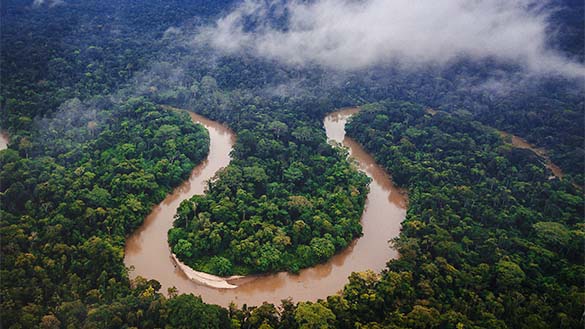
The Amazon rainforest is the largest tropical rainforest habitat in the world. There are a lot less trees in the Amazon rainforest because of deforestation.
Deforestation is when people remove a large area of trees. They cut down the trees to get wood to build things, or to make space to grow crops. The space is also used for animals to graze, or when more people move in.
We will use parts of the Scientific Research Process to learn more about deforestation and how it affects the producers and all other organisms in the rainforest habitat. This includes humans.
Explore the following video about the steps of the Scientific Research Process.
We have already started the Ask step. We can ask the research question, “What might happen if trees were removed from the rainforest habitat food web?”
As you research, you can also use the Record stage.
Press the following tabs to learn more about how deforestation affects the rainforest habitat.
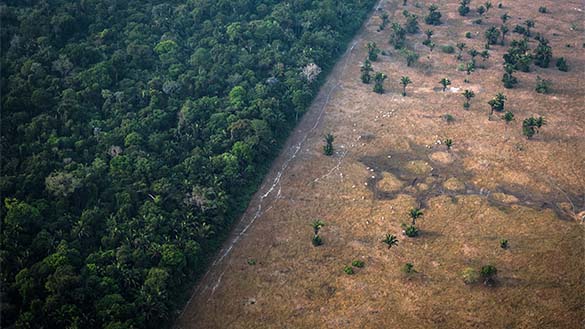
Deforestation
As the world’s largest tropical rainforest habitat, the Amazon is home to between 10,000 and 15,000 tree species. That’s about 1/8th of the all the trees in the world. A recent field study proved that more than half of these species are directly threatened by the impact of deforestation.
The trees of the Amazon Rainforest produce a lot of the world’s carbon dioxide, which is an important part of Earth’s air along with oxygen. Researchers are predicting that the rainforest will be just more than half the size it is now by the year 2050.
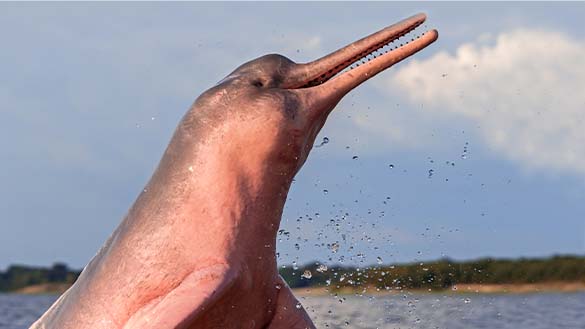
A river dolphin
All the organisms depend on each other within a community. The rest of the habitat will suffer if important producers in the food web (like trees) are affected.
New roads are built when companies move into a forest to start cutting down trees. This damages the natural vegetation that provides shelter to many living organisms in the habitat.
When more dams are built, they block certain fish species and river dolphins from moving.
Cutting down trees takes away shelter for animals that live in treetops, like sloths and Harpy eagles.
Current efforts to reduce the harm
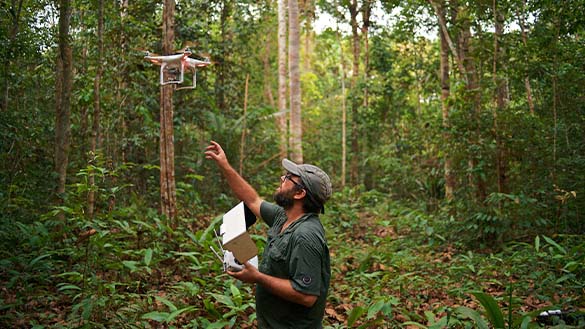
An environmentalist
There are several different ways people are trying to protect the Amazon’s natural habitat. One group is called Aliança da Terra. It is a not-for-profit Brazilian organization of people who work to support farmers in the Amazon and build environmental awareness. A lot of beef is exported from Brazil. More cattle farms and cattle ranches have caused widespread deforestation across the Amazon.
Explore the following video to learn more about how Aliança da Terra is working with local communities to reduce the harm of deforestation. Consider the different ways they are helping farmers!
In which ways does Aliança da Terra help farmers improve their sustainable practices?
Record your response using a method of your choice.
Press ‘Hint’ to access a possible answer.
Aliança da Terra helps local farmers learn how to improve soil health. They also help them learn about how to farm new breeds of cattle that don’t need as much water or land to raise.
Check your understanding
Review the following statements, and decide if they are true or false.
Select the correct answer, then press ‘Check Answer’ to check how you did.
Consider and communicate
Select two of the true statements from the previous true or false activity. In a method of your choice, use your own words to explain why each statement is true.
Examine the following interactive vocabulary checklist as you prepare your response.
I have included the following terms in my response:
Consolidation
Putting it all together
Label a food web
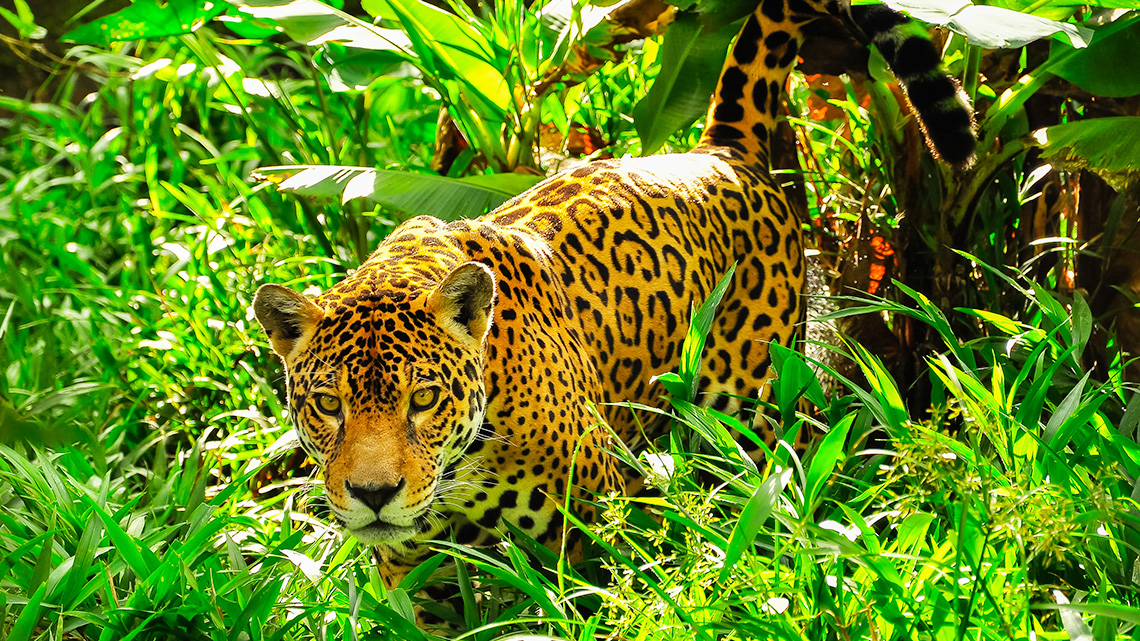
You have explored how a threat to the Amazon Rainforest (removing large numbers of trees), can affect the other organisms in the habitat.
In the following task, consider a habitat of your choice. You could use the rainforest habitat in the following image, or choose a different habitat (e.g., local forest, a pond, the desert, the ocean, etc.).
Then, consider all the producers (plants), consumers (animals), and decomposers that share the space.
Task: Food web
Try to include vocabulary from the learning activity in your answers:
| Organism | Habitat | Community | Interdependence |
| Food chains | Producers | Consumers | Decomposers |
Press ‘Definitions’ to review key vocabulary words.
Let’s revisit the vocabulary!
 Description
Description
A rainforest habitat with many plants and animals. Each plant and animal is labelled as a producer, a consumer or a decomposer. The rainforest has several visible sun rays that filter down from above through the many trees. The producers include banana palms, canopy trees, orchid plants and other green plants. The consumers include a python, a jaguar, a monkey, and a squirrel. The decomposers are the fungi and the mushrooms.
| Vocabulary Word | Definition |
|---|---|
| Orgamism | Any living animal, plant, or fungus that maintains processes that are necessary to live. |
| Habitat | The place where an organism lives and that provides it with the food, water, shelter, and space that it needs to survive. |
| Community | All the populations of plants and animals that live and interact together in a habitat. |
| Interdependence | How plants, animals and sometimes even humans rely on each other for survival within the same habitat. |
| Food chains | A network of feeding relationships within a habitat. This includes organisms such as producers, consumers, or decomposers. |
| Producers | Organisms that take energy from sunlight and turn it into the nutrients they need to survive. Examples of producers are trees and other green plants. |
| Consumers | Organisms that cannot produce their own food or nutrients. They must eat or “consume” plants or other animals to survive. |
| Decomposers | Organisms that break down the bodies or parts of dead plant or animal matter into smaller pieces (decay). Decomposers, such as mushrooms, bacteria, and earthworms, are very important in food webs. |
Reflection
As you read through these descriptions, which sentence best describes how you are feeling about your understanding of this learning activity? Press the button that is beside this sentence.
I feel…
Now, record your ideas using a voice recorder, speech-to-text, or writing tool.